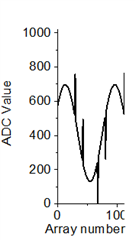Hello, I'm developing SAADC on nRF52832.
While developing, I have problems now.
I applied sine wave on ADC input.
And the result is displayed on the figure that I attached.
It has kind of 'spikes'. (I checked using oscilloscope and saw that input signal doesn't have problem)
Does anyone had same issue like me?
It's bigger than noise, and also they appear regularly.
Thanks a lot.



